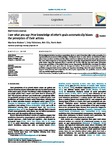I see what you say: Prior knowledge of other’s goals automatically biases the perception of their actions
| dc.contributor.author | Hudson, Matthew | |
| dc.contributor.author | Nicholson, T | |
| dc.contributor.author | Ellis, R | |
| dc.contributor.author | Bach, Patric | |
| dc.date.accessioned | 2015-11-30T12:55:30Z | |
| dc.date.available | 2015-11-30T12:55:30Z | |
| dc.date.issued | 2016-01 | |
| dc.identifier.issn | 0010-0277 | |
| dc.identifier.issn | 1873-7838 | |
| dc.identifier.uri | http://hdl.handle.net/10026.1/3870 | |
| dc.description.abstract |
We investigated whether top-down expectations about an actor's intentions affect action perception in a representational momentum (RM) paradigm. Participants heard an actor declare an intention to either take or leave an object and then saw him either reach for or withdraw from it, such that action and intention were either congruent or incongruent. Observers generally misperceived the hand's disappearance point further along the trajectory than it actually was, in line with the idea that action perception incorporates predictions of the action's future course. Importantly, this RM effect was larger for actions congruent with the actor's goals than for incongruent actions. These results demonstrate that action prediction integrates both current motion and top-down knowledge about the actor's intention. They support recent theories that emphasise the role of prior expectancies and prediction errors in social (and non-social) cognitive processing. | |
| dc.format.extent | 245-250 | |
| dc.format.medium | Print-Electronic | |
| dc.language | en | |
| dc.language.iso | eng | |
| dc.publisher | Elsevier BV | |
| dc.subject | Perceptual anticipation | |
| dc.subject | Intention | |
| dc.subject | Action goals | |
| dc.subject | Predictive coding | |
| dc.subject | Mirror neurons | |
| dc.subject | Visual prediction | |
| dc.title | I see what you say: Prior knowledge of other’s goals automatically biases the perception of their actions | |
| dc.type | journal-article | |
| dc.type | Journal Article | |
| dc.type | Research Support, Non-U.S. Gov't | |
| plymouth.author-url | https://www.webofscience.com/api/gateway?GWVersion=2&SrcApp=PARTNER_APP&SrcAuth=LinksAMR&KeyUT=WOS:000367115500025&DestLinkType=FullRecord&DestApp=ALL_WOS&UsrCustomerID=11bb513d99f797142bcfeffcc58ea008 | |
| plymouth.volume | 146 | |
| plymouth.publication-status | Published | |
| plymouth.journal | Cognition | |
| dc.identifier.doi | 10.1016/j.cognition.2015.09.021 | |
| plymouth.organisational-group | /Plymouth | |
| plymouth.organisational-group | /Plymouth/Faculty of Health | |
| plymouth.organisational-group | /Plymouth/Faculty of Health/School of Psychology | |
| plymouth.organisational-group | /Plymouth/REF 2021 Researchers by UoA | |
| plymouth.organisational-group | /Plymouth/REF 2021 Researchers by UoA/UoA04 Psychology, Psychiatry and Neuroscience | |
| plymouth.organisational-group | /Plymouth/Research Groups | |
| plymouth.organisational-group | /Plymouth/Research Groups/Centre for Brain, Cognition and Behaviour (CBCB) | |
| plymouth.organisational-group | /Plymouth/Research Groups/Centre for Brain, Cognition and Behaviour (CBCB)/Brain | |
| plymouth.organisational-group | /Plymouth/Users by role | |
| plymouth.organisational-group | /Plymouth/Users by role/Academics | |
| dc.publisher.place | Netherlands | |
| dcterms.dateAccepted | 2015-09-27 | |
| dc.identifier.eissn | 1873-7838 | |
| dc.rights.embargoperiod | Not known | |
| rioxxterms.versionofrecord | 10.1016/j.cognition.2015.09.021 | |
| rioxxterms.licenseref.uri | http://www.rioxx.net/licenses/all-rights-reserved | |
| rioxxterms.licenseref.startdate | 2016-01 | |
| rioxxterms.type | Journal Article/Review | |
| plymouth.funder | One step ahead: Prediction of other people's behavior in healthy and autistic individuals.::ESRC |


